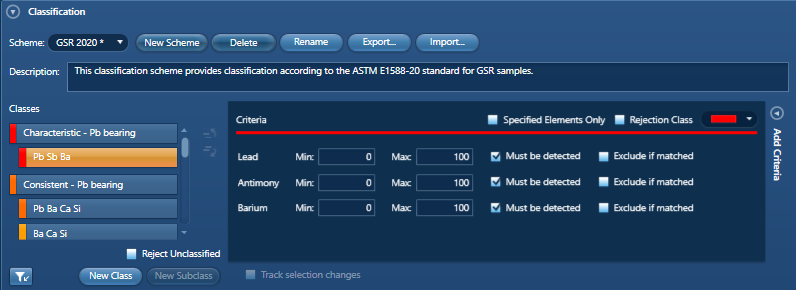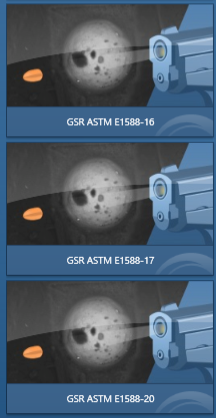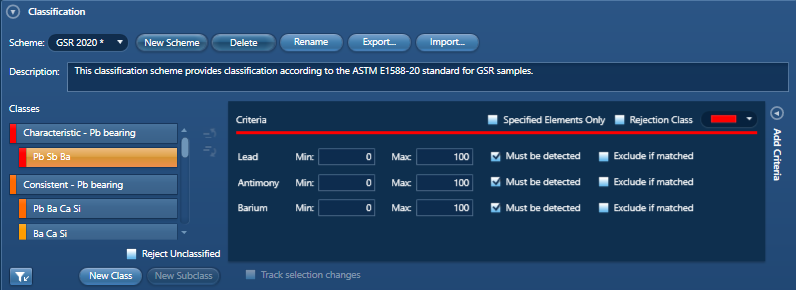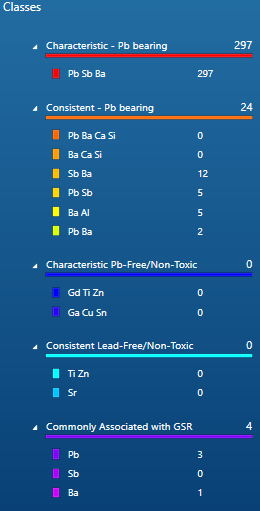14th April 2021 | Author: Dr Matt Hiscock
Classifying Particles to a Standard
Perhaps one of the most critical areas where information acquired with an SEM equipped with Energy Dispersive X-ray Spectroscopy (EDS) is used is in forensics analysis during the study of gunshot residue (GSR). Here the acquired data is frequently used in criminal cases and therefore must be utterly reliable.
GSR particles are small (around a micron or smaller) and have a distinctive composition. There may not be many of these particles in a particular sample, so we use particle analysis to discover and analyse them in the most efficient way possible. This is an approach that detects particles using electron images and then analyses them automatically with EDS.
GSR analysis is performed around the world, and there is a need to know that the analysis performed in one part of a country or continent is comparable to that performed elsewhere. In order to achieve this, an international standard ASTM E1588 has been defined. This standard describes how GSR analysis should be performed and how any particles detected should be classified and described.
AZtecGSR is built upon the AZtecFeature particle analysis platform. AZtecFeature includes a large number of capabilities and functionalities that make it a powerful, flexible and accurate tool. When you purchase AZtecGSR, you are provided with AZtecFeature and a dedicated GSR recipe. This recipe optimises all of the parameters available to you in performing particle analysis, so making setup easily (along with validation and imaging standard samples).
One of those key parameters is the classification scheme. This is perhaps one of the most visible elements of the ASTM E1588 standard. Each time a new version of the scheme is released, our application specialists work through it in forensic (pun intended) detail to understand how best to implement it in AZtecGSR - We provide recipes with the 2016, 2017 and, the recently released 2020 version of the standard for our users as part of the product.
In AZtecFeature/AZtecGSR, the composition of every single particle detected is quantified with the same set of Tru-Q® algorithms that we use for our manually acquired spectra. Tru-Q uses a series of algorithms that are proven to be more accurate than other alternatives.
As we have an accurate, quantified composition for each particle, we can classify each particle by setting up a series of numeric criteria based on what the standard says. These criteria are typically for individual elements – e.g. Pb must be detected between percentage x and y. Multiple criteria can then be combined to make a class. In this way, we can build up collections of classes that implement the rules defined by the standard.
You can see in the image below the rules that are used to detect “Characteristic Pb-bearing” GSR in the 2020 version of the ASTM E1588 standard. Only if Lead, Barium and Antimony are all present in the particle above detection limits and exceeding statistical tests will a particle be classified in this class.

We can apply this classification scheme to a complete analysis of a whole sample and when we do, we end up with a classified dataset with totals presented like this.
The results of this analysis can then be used to determine which particles we want to analyse in more detail and subsequently use as evidence.
I hope this blog has given you an insight into how we write classifications to standards to ensure that any particles analysed can be reported on in the right way. Of course, GSR is not the only application where standards are applied to particle analysis performed in the SEM. There are numerous standards relating to the analysis of non-metallic inclusions in steel, to technical cleanliness in automotive manufacture and what I have discussed here is equally applicable to them.







